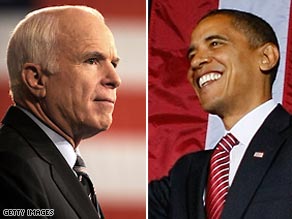(CNN) -- With a week to go before Election Day, most recent national polls show Democratic presidential nominee Barack Obama with an advantage. But how much are they to be believed?

As Election Day gets closer, will the race tighten in the polls?
The most recent national CNN poll of polls showed Obama with an 8-point lead over Republican presidential nominee John McCain, 51 percent to 43 percent. The polls were conducted October 21 through October 26.
Most other national polls show Obama with a lead ranging between 5 points and double digits.
A look at CNN polling during the same period before Election Day in 2000 and 2004 suggests that political observers and campaign supporters ought to be cautious in declaring the race over because of current polling numbers. See the latest state and national polls
When a presidential race has a non-incumbent in the lead, like this year, the poll numbers tend to tighten as Election Day gets closer, CNN senior researcher Alan Silverleib said.
"Any time it looks like they are on the verge of voting somebody new into office, there is buyer's remorse," he said. "Based on that, and the fact that the country has been so polarized in recent elections, there's pretty good reason to think that the polls might tighten up a little bit."
Four years ago, a national CNN poll of polls released about a week before Election Day showed President Bush leading Massachusetts Sen. John Kerry by 3 points, 49 percent to 46 percent.
The poll was released October 25 and reflected likely voters' choice for president. Election Day was November 2 in 2004.
A national CNN poll of polls released November 1 showed Bush leading Kerry by 2 points, 48 percent to 46 percent.
President Bush won by 3 percentage points, 51 percent to 48 percent.
In 2000, it was a bit of a different story. Election Day arrived November 7 that year.
A CNN/USA Today/Gallup tracking poll conducted October 29 through October 31 showed Bush, then the Texas governor, leading Democratic Sen. Al Gore, 48 percent to 43 percent. The poll had a margin of error of plus or minus 2 percentage points.
A subsequent poll conducted November 2 through November 4, released two days before the voters cast their ballots, showed the same results.
Gore, however, ended up winning the popular vote by about 540,000 votes. When broken down by percentage, both candidates had about 48 percent of the popular vote. Bush won the Electoral College, and thereby the presidency, by 5 electoral votes.
There have been a few examples of such "buyer's remorse" in recent history, Silverleib said.
"We saw that with [Arkansas Gov. Bill] Clinton in 1992, when the polls suddenly tightened up during the last week," he said. "It was almost like people saying, 'Do we really want this guy?' "
They did. Clinton soundly defeated President George H. W. Bush, 43 percent to 37 percent.
In another example, polls tightened during the 1968 presidential race between Republican Richard Nixon and Democrat Hubert Humphrey. Nixon led by double digits among registered voters in late September, according to a Gallup analysis published Monday.
The lead dwindled to 8 points in a poll conducted October 17 through October 22. By early November, Nixon was clinging to a 1-point lead. The poll was conducted October 29 through November 1 and surveyed likely voters, according to Gallup.
Nixon won by less than 1 percentage point.
"Humphrey had all the momentum at the end, and there's an open question there that had that election gone on for another week, Humphrey might very well had won," Silverleib said.
There is then the oft-cited example of Thomas Dewey and Harry Truman in 1948. Polls predicted that Dewey would win, but Truman pulled off the upset.
Silverleib, however, is reluctant to cite that race as illustrative of the accuracy of contemporary polls.
"People talk about Dewey and Truman, but they stopped polling a couple of weeks before the election," he said, adding, "polling then wasn't nearly as refined a science as it is now."
However, in what might be a bit of sobering news for the McCain campaign, since 1956, front-runners in late October lost the popular vote only twice after being ahead in the Gallup poll a week before Election Day, according to that polling organization's analysis.
Obama held a lead in both of Gallup's likely voter tracking polls released Tuesday.
'Politics' 카테고리의 다른 글
| McCain Links Economy, Security (0) | 2008.10.30 |
|---|---|
| Sarah Palin (0) | 2008.10.30 |
| Polls show McCain not making up ground in Ohio (0) | 2008.10.29 |
| Obama Campaigns in Final Days Before Election (0) | 2008.10.29 |
| McCain (0) | 2008.10.29 |


